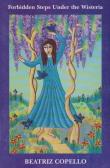AustLit
Latest Issues
Publication Details of Only Known VersionEarliest 2 Known Versions of
Works about this Work
-
Intergenerational War Memories and Exile in Beatriz Copello’s Forbidden Steps Under the Wisteria
2020
single work
criticism
— Appears in: Journal of the European Association for Studies of Australia , vol. 11 no. 2 2020;'This article explores the politics of memory and identity in Beatriz Copello’s novel Forbidden Steps Under the Wisteria (1999). Copello was born in Rosario, Argentina, and emigrated to Australia in the early 1970s. Her semi-autobiographical novel explores the lives of three generations of women through a long migratory journey from Russia via Europe and America, coming to an end in Australia. The main plotline follows the story of Gabriela from her birth to her father’s death in a car crash during her teenage years. The novel’s experimental character and peculiar writing style moves from the symbolic and imaginary world of oneness with nature to the real world of prohibitions and the loss of innocence, and to becoming a woman. It also intertwines issues of identity, place, and time. Through her depiction of traumatic as well as inspiring memories, Copello finds a voice of her own which emerges through her ancestors’ experiences of war and her own exile to a new sense of reconciliation and belonging. Copello’s novel will be discussed within the context of Jacques Lacan’s approximations on language, identity and the symbolic realm.'
Source: Abstract.
-
Soundings from Downunder : Argentine Maturations
2000
single work
review
— Appears in: Antipodes , June vol. 14 no. 1 2000; (p. 67)
— Review of Forbidden Steps Under the Wisteria 1999 single work novel -
From Fractured Fairytale to Tango
1999
single work
review
— Appears in: Australian Women's Book Review , vol. 11 no. 1999; (p. 6)
— Review of Forbidden Steps Under the Wisteria 1999 single work novel
-
From Fractured Fairytale to Tango
1999
single work
review
— Appears in: Australian Women's Book Review , vol. 11 no. 1999; (p. 6)
— Review of Forbidden Steps Under the Wisteria 1999 single work novel -
Soundings from Downunder : Argentine Maturations
2000
single work
review
— Appears in: Antipodes , June vol. 14 no. 1 2000; (p. 67)
— Review of Forbidden Steps Under the Wisteria 1999 single work novel -
Intergenerational War Memories and Exile in Beatriz Copello’s Forbidden Steps Under the Wisteria
2020
single work
criticism
— Appears in: Journal of the European Association for Studies of Australia , vol. 11 no. 2 2020;'This article explores the politics of memory and identity in Beatriz Copello’s novel Forbidden Steps Under the Wisteria (1999). Copello was born in Rosario, Argentina, and emigrated to Australia in the early 1970s. Her semi-autobiographical novel explores the lives of three generations of women through a long migratory journey from Russia via Europe and America, coming to an end in Australia. The main plotline follows the story of Gabriela from her birth to her father’s death in a car crash during her teenage years. The novel’s experimental character and peculiar writing style moves from the symbolic and imaginary world of oneness with nature to the real world of prohibitions and the loss of innocence, and to becoming a woman. It also intertwines issues of identity, place, and time. Through her depiction of traumatic as well as inspiring memories, Copello finds a voice of her own which emerges through her ancestors’ experiences of war and her own exile to a new sense of reconciliation and belonging. Copello’s novel will be discussed within the context of Jacques Lacan’s approximations on language, identity and the symbolic realm.'
Source: Abstract.
-
cArgentina,cSouth America, Americas,
- 1950s




